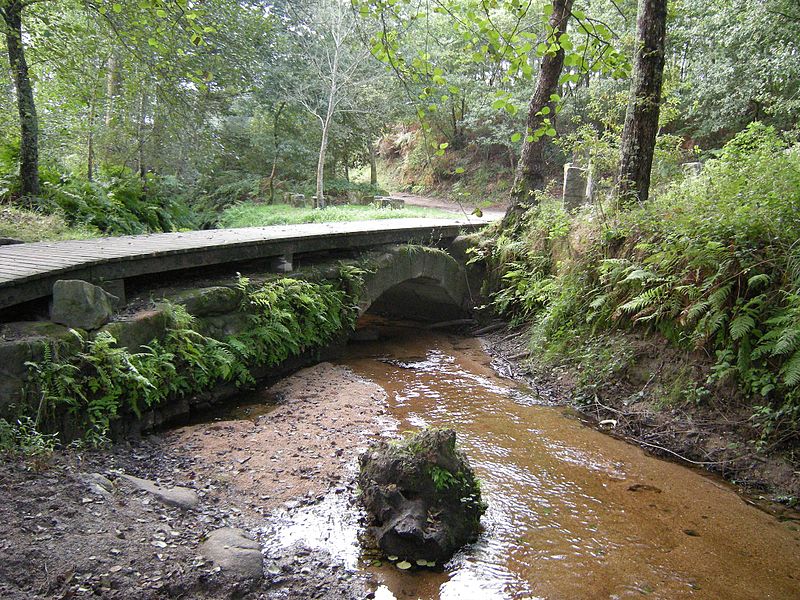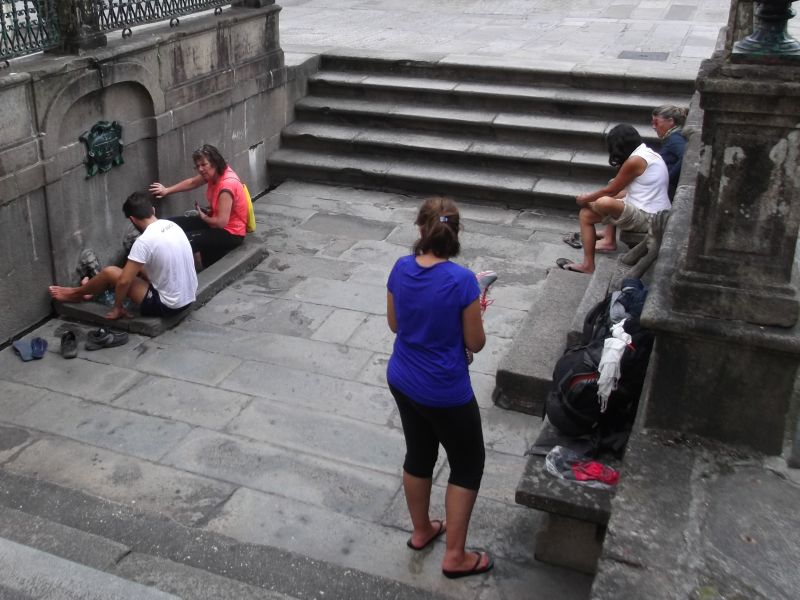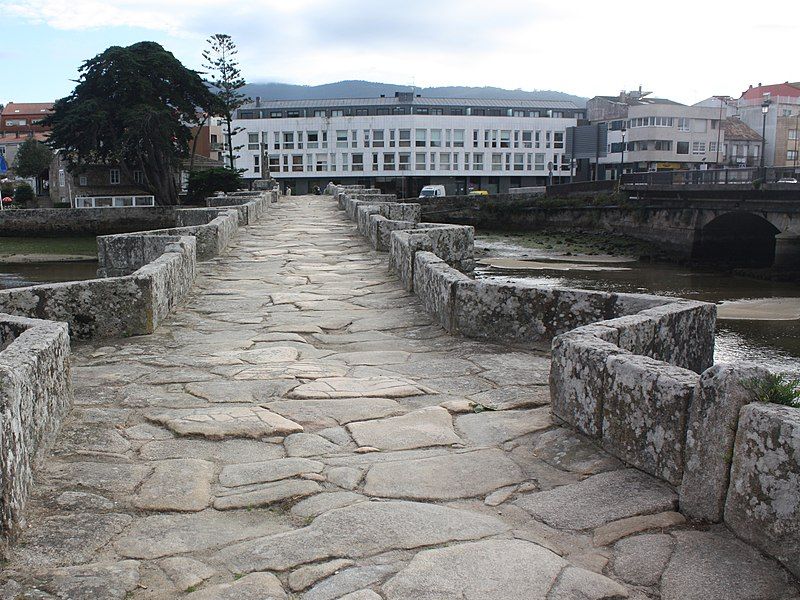

DAY 1: Arrival in Tui by your own means. Accommodation in Tui. *
DAY 2: (TUI-PORRIÑO-19 KM): This first stage is probably the hardest of the entire route. You enter Spain via the International Bridge over the River Miño, whose side platform offers an excellent view of the historic centre of Tui, St. Mary’s Cathedral and the old hospital for the poor and the pilgrims, together with St. Elmo’s Chapel, a walk that submerges the pilgrim in the history that the city walls harbour. You continue on your way following well-sign-posted detours and paths that run parallel to the motorway to enter Ribadelouro and immediately continue through a leafy, pleasant valley, until you reach an important industrial area, the gateway to O Porriño, where you can admire the historic quarter.
DAY 3: (PORRIÑO-REDONDELA-16 KM): We leave O Porriño along the path that goes through the municipality of Mos, where we can visit Santa Eulalia’s church and the Pazo de los Marqueses de Mos. From here the Way ascends to the Alto de Inxertado and passes by the Roman milestone of Vilar de Infesta, which, following the Roman road, crosses the plateau of Chan das Pipas. From the top, you can enjoy beautiful views and begin a steep and swift descent towards Redondela, where you can admire the Convent of Vilavella, a 16th century residence for nuns, and the Pedro Florani viaduct, inaugurated in 1876 and listed as an Asset of Cultural Interest.
DAY 4: (REDONDELA-PONTEVEDRA-18 KM): We leave Redondela past the Chapel of Las Angustias over the railway bridge, and head through a wooded area to Setefontes and Arcade to cross the historic Ponte Sampaio over the waters of the River Verdugo. We will continue to A Canicouva – along an old cobbled road – towards the city of Pontevedra and its Sanctuary of the Pilgrim Virgin.
DAY 5: (PONTEVEDRA-CALDAS DE REI-23 KM): On this stage we cover a total of 22 km of medium difficulty over fairly flat terrain. Thus, to reach the end of this route we must first pass through Pontecabras, Alba, Reiriz, Lombao de Maceira, San Mauro, Ponte Balbón, O Ameal and Tivo. Of particular note on this stretch is the Church of San Martín de Agudelo, in Barro, where the hand of Maestro Mateo can be seen, and we finish in Caldas de Reis.
DAY 6: (CALDAS DE REIS-PADRÓN-18 KM): This stage takes pilgrims into the valley of Bermaña and its centuries-old forests; today we walk through unquestionably beautiful scenery. In addition to these places, you will pass through towns such as Bermaña, Santa María de Carracedo, Eirigo, O Pino, San Miguel de Valga and Infesta. Once in Padrón, you should not miss the Renaissance-style Palacio de Quito, the Casa Museo de Rosalía de Castro or the Camilo José Cela Foundation, and of course you should taste a portion of its famous fried green peppers (some are spicy hot, some aren’t).
DAY 7: (PADRÓN-SANTIAGO DE COMPOSTELA-26 KM): On the sixth and last stage, we set off for Iria Flavia, passing through A Escravitude and its Sanctuary, O Milladoiro, A Rocha Vella and, finally, arriving in Santiago de Compostela via Porta Faxeira, which leads us to Praterías entrance to the Cathedral of Santiago de Compostela.
DAY 8: CHECK OUT AND END OF OUR SERVICES.
PORTUGUESE CAMINO ALTERNATIVE COSTAL ROUTE:

DAY 1: ARRIVAL ON YOUR OWN IN BAIONA. ACCOMMODATION IN BAIONA: We will depart from Baiona, a beautiful municipality with a historic centre and a large number of tourists. The fortress of the Monterreal peninsula deserves a special mention. The Way does not pass through it but it is worth the detour. From the fortress and its surroundings there are splendid views of the Cíes, an archipelago made up of three islands and several islets, which forms part of the Parque Nacional Marítimo-Terrestre das Illas Atlánticas de Galicia, with paradisiacal beaches and a great wealth of landscapes.
DAY 2: (BAIONA-VIGO-23 KM): We advance towards Sabarís and Santa Cristina, where we find several points of interest. The new bridge that crosses the river Guillade following the Camino Real; the old bridge allows the passage over the river Groba and finally, the Romanesque bridge of A Ramallosa, which joins Baiona and Nigrán. We will be able to contemplate the pazo of Pías, which houses the only two-storey granary in Galicia. After climbing the Camiño da Cabreira we cross the motorway between Vigo and Baiona over a flyover and continue through Priegue. On the route we will cross the pazo of Cadaval-Urzaiz, (BIC). We leave behind us Nigrán, which stands out for its sandy beaches and inland forests; and the view of the islands of Estelas and O Monteferro, both natural areas of the Natura 2000 Network. Our steps lead us to Vigo, the largest city in Galicia, where we enter through the Saiáns forest park, with excellent panoramic views.
DAY 3: (VIGO-CESANTES-18 KM): We set course for Redondela. We leave the city through the Ruta del Agua (Water Route), which follows the route of the water supply from the Eiras reservoir and walk towards Rande. We enter the San Simón inlet, with the mouth of the river Verdugo in the background, an area classified as a Site of Community Importance and rich in water birds. It also stands out for the cultivation of bivalves. Off the coast emerges the island of San Simón, which throughout its history has been a monastic centre, a concentration camp, a lazaretto and a home for the training of sailors’ orphans. The island is linked by a bridge to the island of San Antón. On our way we find the pazo of Torrecedeira, already in Redondela, where the railway viaducts and its beautiful historical site are characteristic. After passing the railway bridge we descend to the baroque chapel of Santa Mariña. Our steps lead us to Cesantes.
DAY 4: (CESANTES-PONTEVEDRA-16 KM): From Cesantes we continue towards O Viso and descend to Arcade (Soutomaior), famous for its prized oysters. Crossing the town centre we will find a niche decorated with motifs from the Pilgrim’s Way to Santiago de Compostela. A recommended visit, although far from the route, is the castle of Soutomaior. From Arcade we continue towards Ponte Sampaio, crossing the bridge over the river Verdugo. Further on, we will see the landscape where the Ponte Nova used to stand, a medieval bridge with a single arch that disappeared as a result of a flood in the river Ulló. We arrive at the Brea Vella da Canicouva, a path with historical overtones and cobbled sections, which runs along the route of the Roman road. We then arrive at Figueirido (Vilaboa), continue through Santa Comba de Bértola, until we reach Pontevedra. Monumental city with a beautiful historical site.
FROM HERE ON WE CONTINUE ALONG THE SAME STAGES FROM PONTEVEDRA TO SANTIAGO
INCLUDED
– Accommodation in double or single room. Breakfast incl.
– Transport of backpacks for each of the stages along the route (max. 15 Kg per backpack).
– Accommodation along the way: Hotels, rural houses, hostels or pensions.
– 1 Guided tour of Santiago (historic centre): 2h in Spanish.
– Informative dossier.
– Travel insurance with 24-hour telephone assistance service.
NOT INCLUDED
– Support car. Transfers IN/OUT
OPTIONAL SERVICES
– Discount for third person in extra bed sharing room with 2 adults 10%.
– Half board supplement (no discount for 3rd person) per person/night €18.00
– Picnic lunch supplement: sandwich, drink and dessert person/day €9.40
– Santiago-Sarria airport transfer supplement: (max. 4)* €162.50
– Santiago city to Santiago airport transfer supplement: (1 to 3 people) €41.25
– Santiago city to Santiago airport transfer supplement: (4 to 7 people) €63.75
– Private transfers and/or support car during the route: please ask.
– Cancellation insurance: please ask.
* FLIGHT DELAYS OR WAITING FOR LUGGAGE CLAIM: €25.00/HOUR
